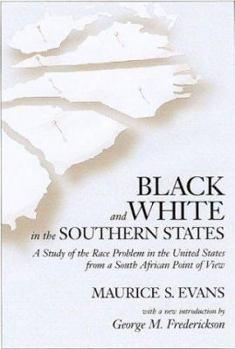Black and White in the Southern States: A Study of the Race Problem in the United States from a South African Point of View
(Part of the Southern Classics Series)
Select Format
Select Condition 
Book Overview
Compares race relations in the American South during the early 1900s to those in South Africa
Reprinted here for the first time since its publication in 1915, Black and White in the Southern States by Maurice S. Evans, a British immigrant to South Africa in 1875 and a founder of the Union of South Africa in 1910, is one of the earliest studies in comparative race relations and the first to connect the experience of the American South experience to that of South Africa. Evans, a perceptive observer and a surprising critic of American race relations, was an objective chronicler of the South during the segregation era. This work is a synthesis of the observations Evans made as he traveled the southern United States in 1914 to examine race relations. During this trip he investigated southern metropolitan life, industrial relations and the workplace, and social and cultural connections. Evans's study presents a revealing assessment of racial attitudes and ideologies in the Jim Crow era. In his introduction to this edition George M. Fredrickson, the preeminent scholar who defined the field of comparative racial ideologies, analyzes the underlying racist character of Evans's work. Fredrickson places Evans's work in its full intellectual social context.
Evans's overarching question was whether or not black and white races could share the same geographical region and, if they could, under what conditions. He learned quickly that, for the South, this was a moot question. Historical circumstances prevented a geographical separation, even though some black and white southerners vainly advocated that course. The history of the American South served as an object lesson for South Africa--a revelation of the consequences of incomplete racial segregation. Evans explains how white southerners, unable to separate the races physically, created legal and cultural bars to segregate the races. Concluding that the South was a poor model for "solving" race questions, Evans suggested that South Africa might solve its problem by maintaining strict territorial division, thereby avoiding the discriminatory, punitive Jim Crow culture of the American South.





